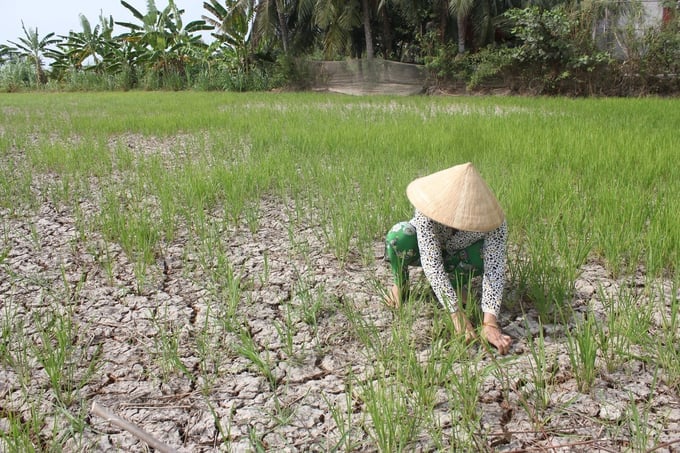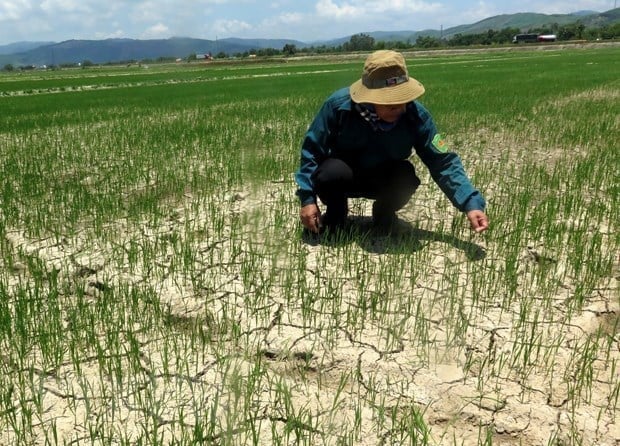November 22, 2025 | 09:18 GMT +7
November 22, 2025 | 09:18 GMT +7
Hotline: 0913.378.918
November 22, 2025 | 09:18 GMT +7
Hotline: 0913.378.918
According to the Ministry of Agriculture and Rural Development, the level of saltwater intrusion in the Mekong Delta region between the beginning of the dry season and March 26 has increased considerably compared to that of the multi-year average and the same period in 2023. However, the severity of the intrusion is lesser compared that of the 2015-2016 and 2019-2020 saltwater intrusion episodes.

According to the Ministry of Agriculture and Rural Development, over 20,000 hectares of rice production areas are currently vulnerable to drought and saltwater intrusion. Photo: MH.
To date, approximately 20,000 hectares of rice production areas, including 30 hectares in Tien Giang province, 730 hectares in Ben Tre province, 13,000 hectares in Tra Vinh province, 6,000 hectares in Soc Trang province, 720 hectares in Long An province, are vulnerable to drought and saltwater intrusion. Despite recommendations to sow after December 31, 2023, farmers in several regions began cultivating rice behind schedule. Consequently, 621 hectares of rice production areas in Soc Trang province have been damaged.
Regarding domestic water supply, approximately 50,500 households (accounting for 3.6% of the total number of households) are facing shortage issues, including 12,000 households in Ben Tre province, 20,000 households in Kien Giang province, 6,400 households in Soc Trang province, 4,900 households in Bac Lieu province, 3,900 households in Ca Mau province, and 3,300 households in Long An province. Accordingly, the affected residential areas are located in groundwater-depleted regions. Furthermore, the surface water sources from various centralized water supply infrastructure exceed permissible salinity levels. Notably, several households are not receiving water from centralized supplies, and lack adequate freshwater storage facilities.
Regarding the effects of drought in the Central region, approximately 2,400 hectares of rice and fruit trees (accounting for less than 1% of the total production area) in Quang Nam (1,500 hectares of rice) and Binh Thuan (909 hectares of dragon fruit) are affected by drought and water shortages. Due to a prolonged dry season which can last until late July or early August 2024, the region will continue to face the risk of drought and water shortages in the near future. Moreover, the effects of adverse weather conditions can be exacerbated by intense heatwaves and the rapidly declining water levels in local reservoirs.
Following efforts to balance water supply, the total affected production area for the 2023-2024 winter-spring crop is estimated between 3,700 and 5,700 hectares (accounting for less than 1% of the total production area). Accordingly, the affected areas include 1,000 to 1,500 hectares in Nghe An province, 1,700 to 2,500 hectares in Quang Nam province, 500 to 700 hectares in Phu Yen province, and 500 to 1,000 hectares in Binh Thuan province. On the other hand, the total affected production area for the 2024 summer-autumn crop is estimated between 15,500 and 21,000 hectares (accounting for 2 to 3% of the total production area), including 7,500 to 11,000 hectares in the North Central region, and 8,000 to 10,000 hectares in the South Central region.
Over 9,800 hectares of crops (mainly perennial crops) are currently affected by drought and water shortages in the Central Highlands and Southeast region. These affected areas include 101 hectares in Gia Lai province, 63 hectares in Dak Lak province, over 1,800 hectares in Lam Dong province, and over 7,800 hectares in Binh Phuoc province. Notably, 66 hectares of rice and flower production areas in Gia Lai province have been completely damaged. Accordingly, these areas are isolated from local irrigation infrastructure.

Approximately 2,400 hectares of rice and fruit trees (accounting for less than 1% of the total production area) in Quang Nam and Binh Thuan provinces are affected by drought and water shortages. Photo: MH.
The local drought and water shortages are forecast to continue until the end of the dry season across several small reservoirs, run-of-the-river dams, and areas isolated from local irrigation infrastructure. The total affected area is estimated to reach between 23,000 and 37,000 hectares, including 15,000 to 26,000 hectares in the Central Highlands, and 8,000 to 11,000 hectares in the Southeast region. The affected areas represent approximately 1 to 2% of the total production area.
The average capacity of common irrigation reservoirs in the Northern region currently ranges from 57 to 70% of the design capacity, which is lower than the multi-year average and that of the years between 2021 and 2023 by 5 to 15%. The current level of stored water is enough to supply irrigation for the winter-spring crop.
However, areas drawing water from the Red River for rice irrigation are experiencing shortages due to low water levels in the Red River - Thai Binh River system. Furthermore, the ineffective operation of irrigation infrastructure has resulted in the risk of localized water shortages in provinces of Vinh Phuc, Hung Yen, Hai Duong, among others.
Translated by Nguyen Hai Long

(VAN) Water resources during the 2025–2026 dry season in the Mekong River Basin basically meet domestic use and production needs, but localized shortages may still occur due to saltwater intrusion.

(VAN) Vietnam and Japan have committed to deepening cooperation on projects under the Joint Crediting Mechanism (JCM), improving waste management, and advancing the circular economy.

(VAN) Digital transformation is becoming a core driver of proactive, precise, and safer management of dams and reservoirs nationwide.

(VAN) This assistance supports people who temporarily relocate or evacuate, as well as communities affected by major storms from late September to now.

(VAN) Viet Nam will host the 8th ASEAN Heritage Parks Conference, bringing together over 320 delegates and reaffirming its role in regional nature conservation.

(VAN) According to MAE, heavy rains and flooding from November 16-19 caused major losses in lives, homes, and agricultural production across the central provinces.

(VAN) Amid vast floodwaters, the spirit of sharing and helping others shown by many people in Gia Lai reached tens of thousands of residents stranded by raging floods.